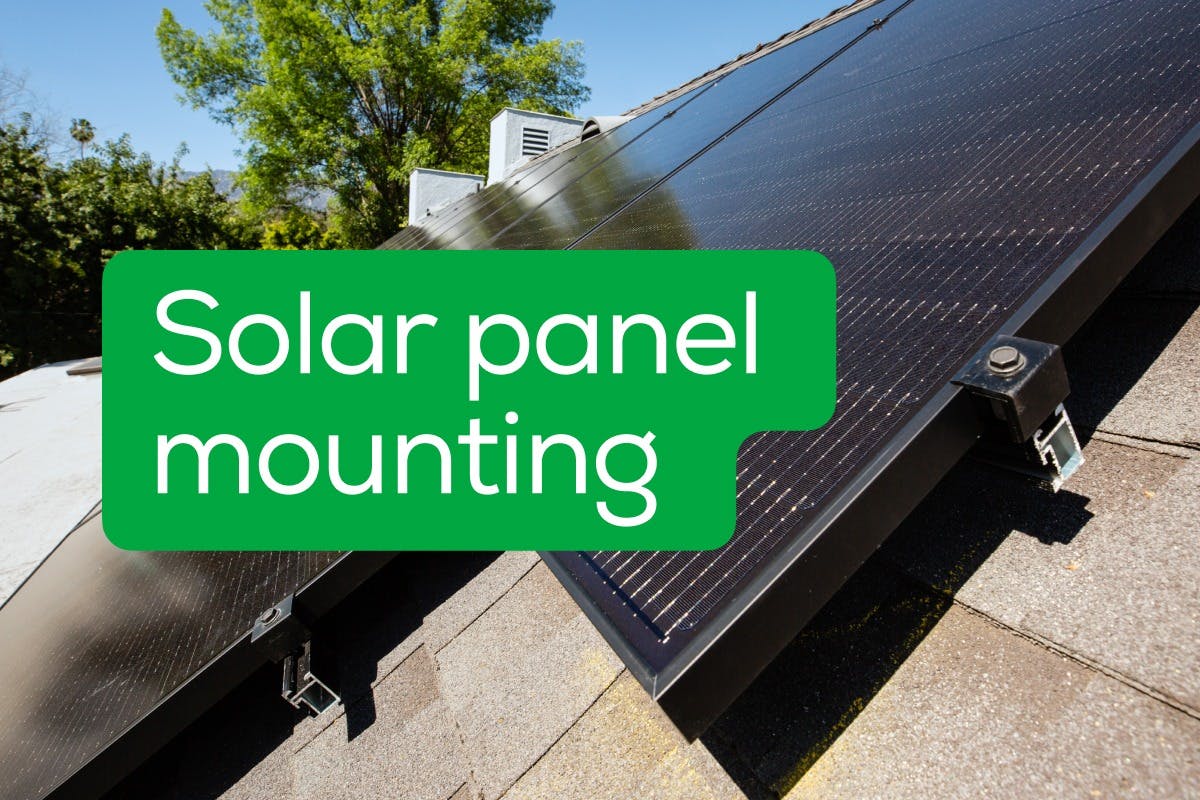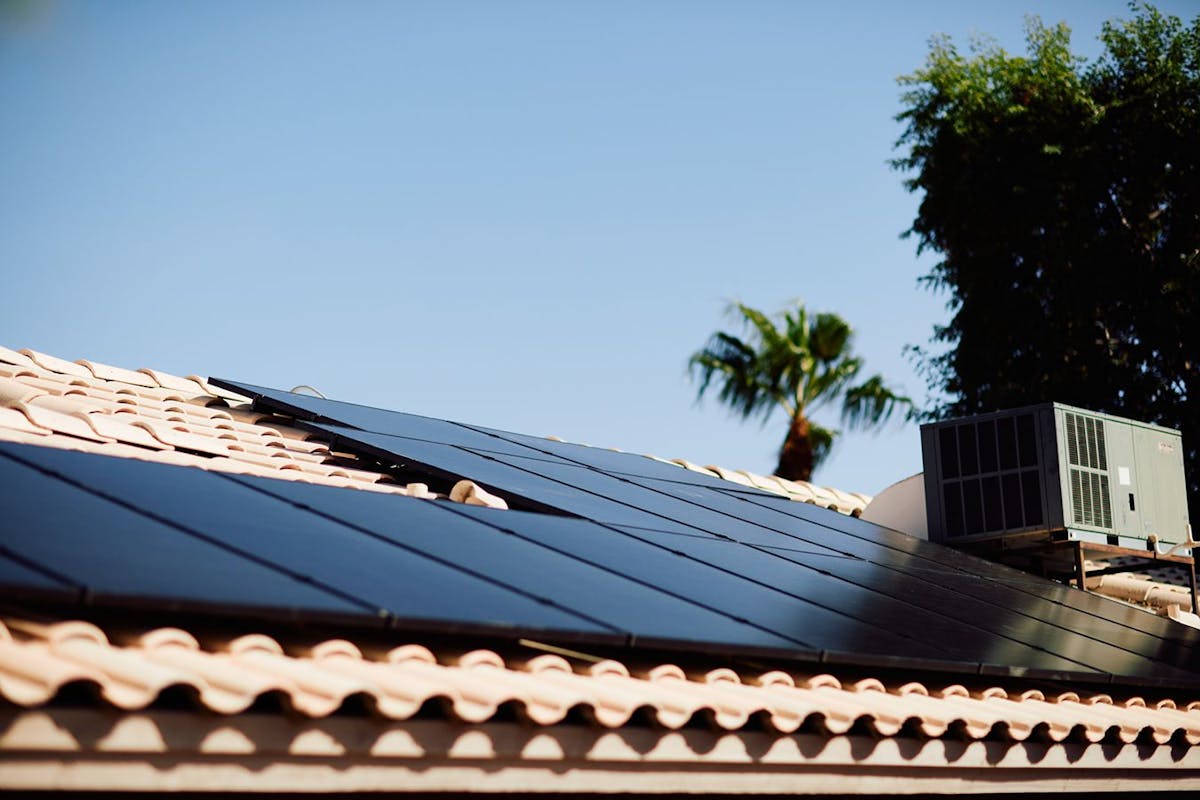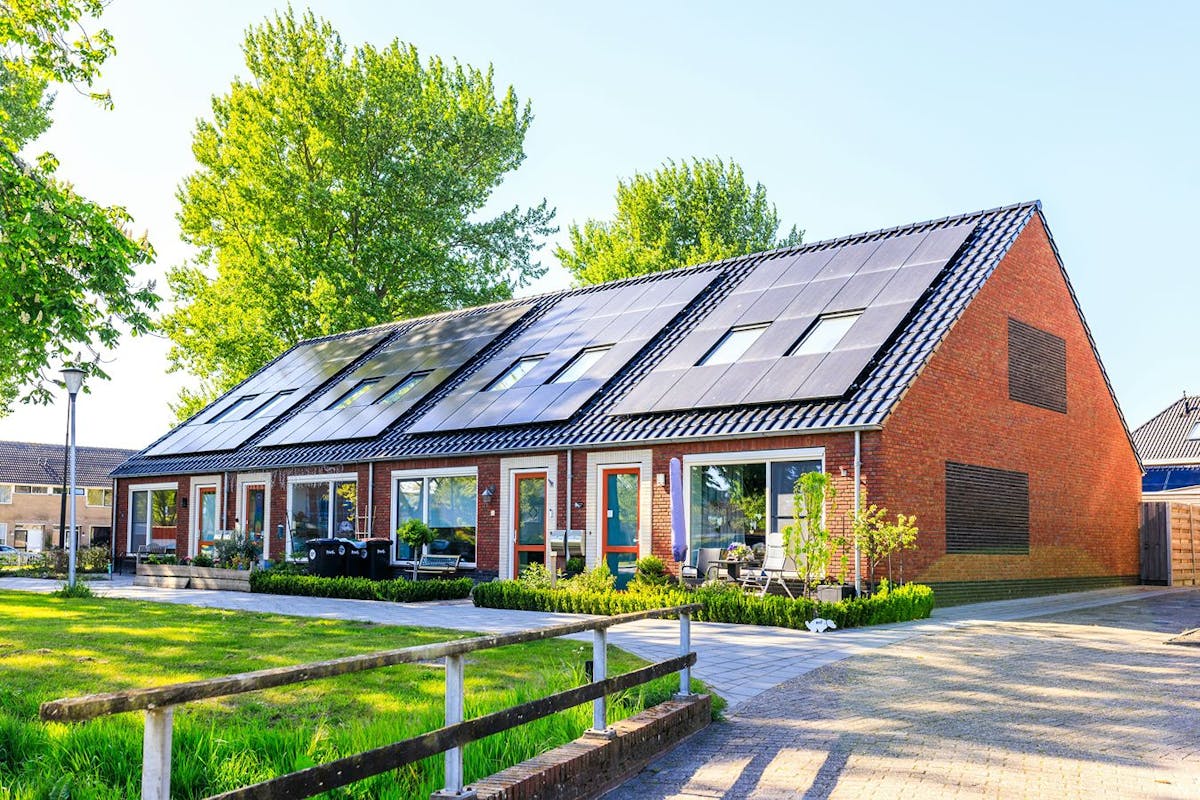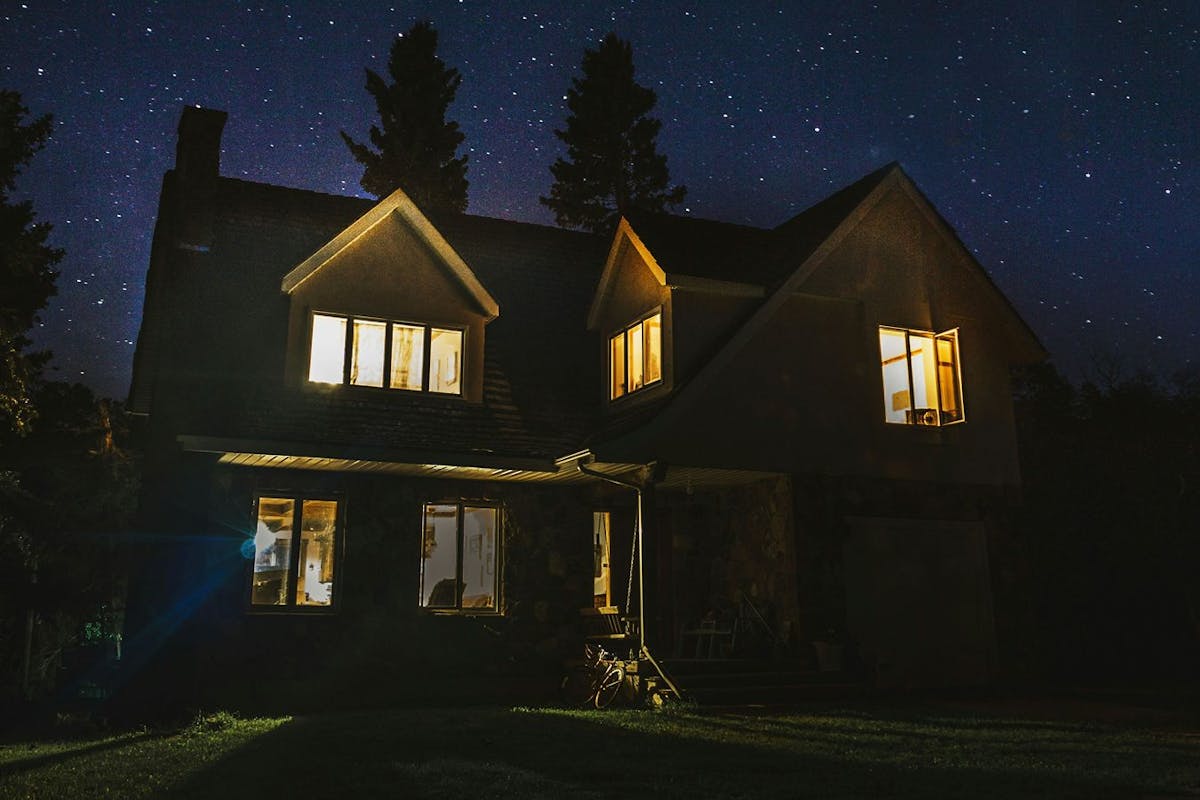Solar Panel Mounting and Racking: An Overview
Last edited

Author
Andrew Giermak
Solar and Electrification Writer and Editor

Editor
Ryan Barnett
SVP, Policy & New Market Development

Home solar panels need to be mounted on special racking. While you won’t need to go up on your roof and work on a system’s racking, knowing more about how professionals mount solar panels may give you more understanding of your solar system and how it works.
To protect your home and solar system throughout its lifespan, even through rarities like hurricanes or blizzards, having mounting and racking done right by experienced professionals is an important, if maybe boring, piece of going solar.
See how much you can save by going solar with Palmetto
What Are Solar Panel Racks and Mounts?
Solar module racks and mounts hold solar panels in place on a roof, on a building facade, or in a ground-based array of panels. Mounts safely secure a full array. Racking, sometimes called rails, are metal tracks which hold panels in place, and at the right angle.
Mounts and racks must hold up through conditions such as strong winds, moisture, pest animals, ice, and snow through the lifespan of panels and a system, which is meant to be 25 years or longer.
Solar Panel Mounting Hardware
Here are four pieces of hardware usually required to properly mount a new system.
Mounts: Used to support the entire installation, solar panel mounts such as L-feet (named for their resemblance to the letter “L”), can be lagged into the roof rafters (named for the large lag bolts that are used) to provide a safe and secure place for the system to sit.
Flashings: In conjunction with the mounts, solar flashings provide a waterproof barrier to prevent leaks from rain or snow. Flashings are typically made of rubber, aluminum, or galvanized metal.
Racking: On top of the mounting hardware, rails or racks, are long, aluminum tracks installed horizontally to bear the weight of the panels and prevent them from sliding off of the roof.
Clamps: To ensure every component will stay in place, solar panels are also usually secured to the rails with a system of stainless steel screws and clamps.
The Solar Mounting Process
Unless you’d like a leaky roof and potentially airborne panels during the next major weather event, mounting a solar energy system is more complicated than putting panels on your roof.
Once the solar design has been permitted by your local government and utility, professional solar installers then take the following steps to ensure the system will be approved for safe operation and performance:
1. Installing the mounts: First, mounting brackets are placed on your roof so the solar panels will have a place to sit. Solar mounts are typically attached directly to roof rafters for sturdiness and may require penetration to properly anchor the system. Here, your installer will ensure the mounts are properly sealed and covered to be watertight and resistant to corrosion or damage.
2. Installing the solar panels: Once the mounts are installed, most companies add long metal components called “rails” to further support the panels. While some “railless” systems allow solar panels to be placed directly on mounts, railed or racked methods are more common. On top of each horizontal rail, solar panels essentially “snap into place” with support against heavy weather conditions on a sloped roof.
3. Installing the electric wiring: After the solar panels are in place, the system is wired so electricity can be generated and sent to the home and grid. To protect against outside conditions, wires are contained in a metal conduit which is fed into the inverter, electrical meter, and other system components.
How Much Does Solar Racking Cost?
The cost of solar module racking for a residential system depends on factors such as the roof, the system size and layout, the type of racking and mounting recommended by the installer, and labor costs in your area.
Estimates from a report in 2022 from the National Renewable Energy Laboratory puts the average cost of racking and installation of the racking at about $31.50 per square meter of an array. NREL’s study used a 22-panel array and a 7.9-kWh solar system, which would be about 37.4 square meters, making the estimated cost of racking about $1,178.
Choosing the Right Solar Mounting System for Your Home
While the basic components for solar module mounting are fairly universal, choosing the right hardware for a single installation must be made based on a few specific variables.
Critically, solar mounting should not be about finding the lowest-cost option. While high-quality materials may be more expensive upfront, a safe and secure installation is 100% worth it when considering the potential consequences of roof damage from shoddy parts, poor craftsmanship, or voided warranties.
Here are four key things that are considered when selecting the best roof-mount system.
Aesthetics
With a minimal amount of visible equipment, most solar panel racking systems look more or less the same to the untrained eye, as the majority of the hardware is hidden below the panels. From the street below, passersby will usually only be able to see the panels, parts of the rails, and a small fraction of the mounting materials themselves.
While some solar options may include a “skirt” over the edge of the panels to hide the underside of the solar array, skirts are typically not recommended as they can collect debris and encourage animal nesting.
If you have visibility concerns from your HOA, we encourage you to talk to your installer about solar access laws in your area. There are many parts of the country with legislation in place that prevents HOAs from banning renewable energy systems, no matter their appearance.
Of course, to comply with local aesthetic guidelines, experienced solar companies may be able to adjust various aspects of the system installation. This includes special mounting materials to level panels on an uneven roof, installing wiring conduits away from the street, and painting select system components in dark or neutral tones when required.
Leak protection
To protect against pooling, leaks, and physical property damage, solar panels are installed with a small, intentional gap between the modules and the roof. With horizontal rails sitting on top of the mounting points, properly installed solar panels will not prohibit debris or water from traveling down and off of a roof, helping to prevent the possibility of mold, rot, and even electrical fires.
Leak protection is important, and every experienced solar installer should have a clear plan to meet local building standards and best practices for waterproofing and flashing. For the best results, flashing and sealant choices should be selected based on roofing materials, as well as typical local weather conditions. Leak protection for metal roofs will be a lot different from the process for asphalt shingle or wood shake, for example.
See how much you can save by going solar with Palmetto
Installation ease
The longer a professional solar installation takes place, the more you may end up paying for labor costs. So for the efficiency of their operations and value to their customers, most trustworthy solar installers prefer a mounting solution that is easy to install and proven to withstand the test of time.
Here, we almost always suggest allowing a professional installer to supply their own mounting equipment, as many companies will not even consider third-party materials. By allowing a reputable installer to handle the installation end-to-end, it is more likely the entire process will be handled with speed, efficiency, and consistent quality throughout.
Roof shape and attributes
Finally, the shape of your roof and its physical attributes can influence your solar panel mounting system choices. Dramatically sloped roofs with a steep tilt angle may require a bit of extra care when it comes to safety, and rail-based systems are almost always recommended to add a layer of protection against high winds and heavy weather systems.
Depending on your roof's attributes, installers may be limited to a few creative solutions to roof mount all of the panels safely. While working around chimneys, air conditioning units, and other obstructions, mounting materials must be able to properly support the panels wherever they fit for maximum sun exposure.
When working with your installer, you can ask them how well their mounting materials will work with the unique aspects of your specific roof. If there are limited obstructions, most solar panels can be installed in uniform lines, while sharing long rails mounted with ease and security. Otherwise, more creative systems may be necessary for oddly-shaped roofs.
The Top Brands for Solar Panel Mounting Hardware
While it never hurts to research solar panel mounting hardware, most solar companies prefer to supply their own equipment to ensure a high-quality installation. No matter what brand a company carries, you can ask about the following aspects of their mounting hardware to ensure it is sturdy, safe, and reliable:
Warranties: If a manufacturer offers both parts and craftsmanship warranties on their solar panels, that's a good sign that they believe in the quality of their product and their ability to install it. High-quality solar panel mounting hardware should be durable, resistant to corrosion, and fit for life outdoors.
Compatibility: Before an installation, it is important to make sure the solar mounting is compatible with your roof and panel type. Different mounting hardware will be better suited for different kinds of roofs, so you can ask a company about their previous installations on shingles, tile, or whatever materials are on top of your home.
Aesthetics: Although most mounting hardware will end up hidden beneath your panels, ask your installer whether or not there will be any exposed equipment. Often, reputable installers will be able to show you images of previous installations to get a better idea of expected aesthetics.
These solar module racking providers are some, but not the only, quality racking providers.
IronRidge solar racking and mounting
IronRidge solar racking and mounting offers excellent products with long warranties, and solutions for every kind of roof system. Based in California, IronRidge is among the top choices for installers and manufacturers in the US. Ironridge’s products include two unique flush mount systems. IronRidge makes it easy to install a new solar system or expand on an existing array.
Unirac solar PV racking
Also manufactured in North America, Unirac is another reputable solar panel mounting hardware brand with industry-leading quality standards. Unirac solar PV racking offers a wide range of support options, including full-color installation manuals, video tutorials, a phone hotline, and an online chat feature for their catalog of hardware choices. Unirac has mounting options including rail-based systems, railless systems, and a variety of attachments for solar panels and supporting equipment.
SnapNrack
With systems designed for easier installation, SnapNrack is another solar panel racking system manufacturer based in the United States. The company has a few main racking options, including a “universal” system for roofs of any pitch or material, as well as rail and modified railless choices.
All sold with competitive warranty periods, SnapNrack, Unirac, and IronRidge are all high-quality solar panel mounting systems supported by today’s leading installers.
Roof-Mounted vs. Ground-Mounted Solar Panels
Most home solar panel systems go on roofs, so most mounting and racking hardware is made to securely and stably attach panels to roofs. Panels can be mounted to roofs with steep and shallow pitches made of shingles, tiles, metal, and more.
Most residential solar panels are mounted on roofs because it is a readily available space, is often unshaded, and provides a structure to hold the panels up.
In cases where the roof is shaded, too small, or otherwise unsuitable for solar panels, ground-mounted solar panels may work. Ground-based solar panels and arrays need professional-grade mounting and racking as well and can be designed for the best angle for solar production. Ground-mounted panels can be a bit more expensive because they require additional equipment. Some systems may have adjustable racking, allowing for changing the angle for optimal generation throughout a year.
Getting the Right Solar System for Your Home
Solar panel mounting should be performed by a professional. When trying to find the right professional, knowing how a typical solar installation is performed can help you and your installer determine the best racking solution for your home.
If you're ready to find the right equipment for your home solar panel installation, talk to Palmetto today. We will work with you to determine the best racking hardware for your roof so you can be worry-free throughout the multi-decade lifespan of your system.
To get started you can use our solar savings calculator to see how much you can save by going solar today.
See what solar can do for you:
Frequently Asked Questions
What is racking in solar panels?
Racking, or rails, are long, aluminum tracks installed horizontally on your roof. They safely hold the weight of the solar panels and prevent them from moving or sliding, especially in high wind, heavy storms, or winter weather.
What is the best way to mount your solar panels?
The best way to mount solar panels is to have a professional do the job. Mounting solar panels yourself has unnecessary risks to your personal safety, system functionality, the long-term security of the mounting and panels, and warranty or contract terms.
Can you walk on solar panels?
No, walking on solar panels could damage them. It’s also dangerous and could result in personal injury or death.


